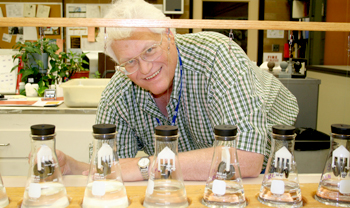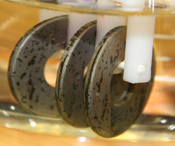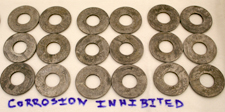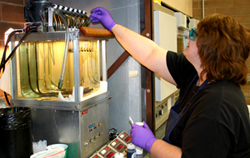
| CONNECTIONS |
IDAHO
ITD
HOME
511 TRAVEL SERVICES
IDAHO
DMV
ITD
NEWS
HIGHWAY
SAFETY
IDAHO STATE POLICE
STATE OF IDAHO
NIATT
NATIONAL
AASHTO
AAMVA
AAA of IDAHO
FEDERAL HIGHWAYS
FEDERAL AVIATION
IDAHO STATE POLICE
NHTSA
NTSB
TRB
U.S. DOT
TRANSPORTER
Archives
Milestones
Comments
Idaho
Transportation
Department
Office of Communications
P.O. Box 7129
Boise, ID 83707
208.334.8005
Fax: 208.334.8563

ITD adopts 'Wright' way to de-ice winter roads

By the time the snow begins to fall at the start of a major winter storm, ITD crews already have applied deicer to many of the state’s main highways. What kind or amount depends on the district, but only one man and his team of chemists and technicians test the products for the entire state to ensure the quality of the materials remains consistent.
How deicers work Solid deicers, such as salt, first must attract or come into contact with sufficient moisture to form a liquid brine. Therefore, pre-wetting is a common practice. The brine has a lower freezing point than water, causing ice and snow to dissolve on contact. |
Ron Wright is an internationally acclaimed chemist who has spent the last 20 at the helm of ITD’s materials and chemistry lab at Headquarters. He is a founding member of the Pacific Northwest Snowfighters Association and has made technical presentations regarding deicing materials and other subjects to transportation representatives from South Korea, Scandinavia, Europe and Canada, as well as throughout the United States.
It’s not unusual for him to get calls from Massachusetts, New York, other states in the Northwest asking about deicing products or specifications that meet certain climatic or structural requirements. In November, Wright was one of the keynote speakers at a conference in Texas where his strategic plan for dust abatement was adopted and is now in the process of being implemented.
Tucked away in an unassuming building at the back of the ITD Headquarters campus, Wright manages the day-to-day task of simultaneous experiments testing everything from cements, curing compounds, deicers, traffic line paints, structural coatings, pavement markings and fencings, to used oil from ITD trucks, soils and water.
He also tests new products under consideration by ITD.
“I provide the quality assurance that products purchased by ITD meet specification standards,” Wright explains. A part of that process includes making sure all materials used by the department meet state and federal environmental standards.
 Recently, he performed an experiment on five deicing materials to determine which ones were the most corrosive. He also tested the effectiveness of corrosion inhibitors in deicers. After three days of dipping steel washers into beakers filled with the various deicing materials, the results were remarkable.
Recently, he performed an experiment on five deicing materials to determine which ones were the most corrosive. He also tested the effectiveness of corrosion inhibitors in deicers. After three days of dipping steel washers into beakers filled with the various deicing materials, the results were remarkable.
“You clearly see how the anti-corrosive inhibitor agents in magnesium chloride, for instance, prevent any sort of noticeable deterioration in the metal,” Wright says. “The metal coupons dipped in magnesium chloride look almost the same as the ones I dipped in distilled water.”
 While the washers were awash in deicing solvents, across the room, oil from ITD trucks was being analyzed as part of the department’s Preventive Maintenance Program.
While the washers were awash in deicing solvents, across the room, oil from ITD trucks was being analyzed as part of the department’s Preventive Maintenance Program.
“By routinely testing samples of the actual used oil in our trucks, we can anticipate maintenance issues and get them taken care of before they become a problem,” he says.
He writes many of the specifications for pavement markings, deicer chemicals, structural coatings for bridges and chemically treated timber. He also writes contract specifications for products used by state forces such as traffic line paint, preformed tape, thermoplastics pavement markings, and glass beads used in the pavement markings. He also conducts forensic analyses on products that failed while in use.
 “It’s busy around here,” he says, looking about the room. “Any day of the week, you’re likely to see rebar sticking up from a bucket of some solution, or chemicals applied to wood. “This is the behind-the-scenes stuff that no one thinks about, but ensures that bridges and roads are built with quality materials that will withstand time and provide a safe means of travel throughout Idaho.”
“It’s busy around here,” he says, looking about the room. “Any day of the week, you’re likely to see rebar sticking up from a bucket of some solution, or chemicals applied to wood. “This is the behind-the-scenes stuff that no one thinks about, but ensures that bridges and roads are built with quality materials that will withstand time and provide a safe means of travel throughout Idaho.”
As for deicers, Ron recommends that people wash their cars after a storm. Deicing liquids along with slush and dirt from the road can splash onto your car and build up over time, leaving a filmy or white residue.
Published 1-16-9